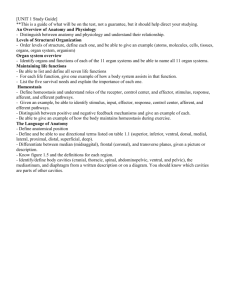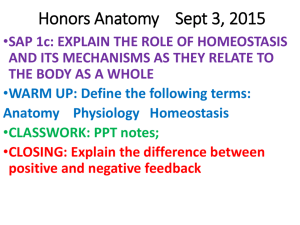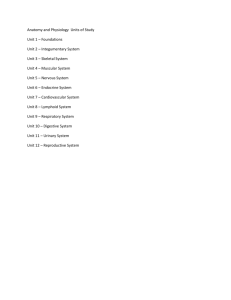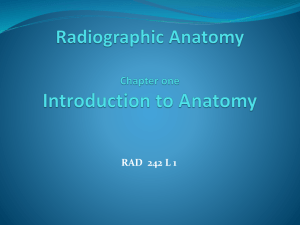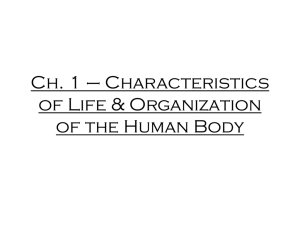The Human Body - mechalskesbiology
advertisement
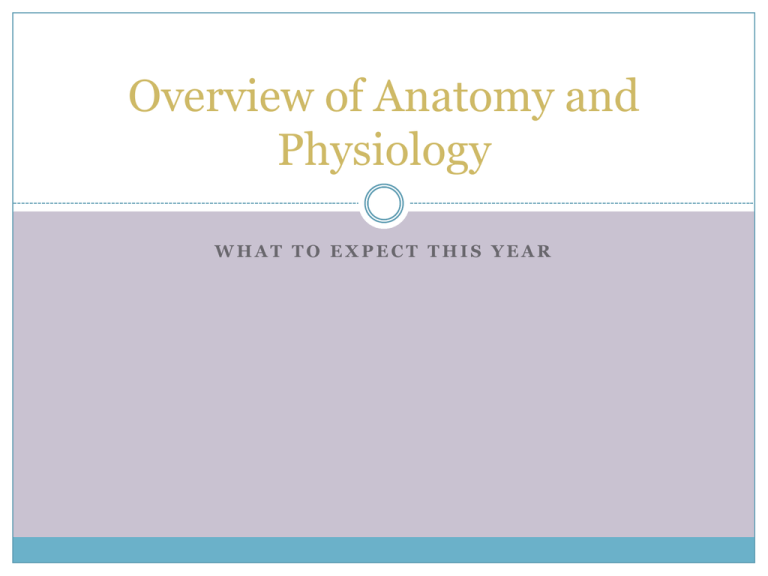
Overview of Anatomy and Physiology WHAT TO EXPECT THIS YEAR What is It? The branches of anatomy and physiology are complementary to each other Anatomy is the study of the structure of the body parts and their relationships with one another Gross anatomy or macroscopic-study of LARGE body structures (those that would be visible with the naked eye) Microscopic anatomy-cannot be seen with the naked eye, must use a microscope Developmental anatomy traces structural changes that occur in the body through life (embryology) Physiology deals with the study of function of the body The Subdivisions of Anatomy Gross Anatomy Microscopic Regional anatomy- Cytology-study of cells studies the structures in a particular region Systemic-system by system Surface-study of internal structures as they relate to the overlying skin Histology-study of tissues Levels of Organization The human body has many levels of organization The most basic is the chemical level (chapter 2)-at this level atoms combine to form molecules which will combine to make organelles Organelles make cells (chapter 3) Cells make tissues (chapter 4) Tissues make organs which in turn make organ systems (chapters 5-27) How Do We Live? Maintaining boundaries- internal environment remains distinct from external environments Movement Responsiveness (irritability)-ability to sense changes in the environment and respond Digestion Metabolism-breaking substances down Excretion-removing wastes Reproduction Growth Nutrition Pause-Activity 1 Break into 9 groups Each group will have a different topic of how we live and will create a poster You will only get ONE piece of construction paper You must include the following: What is your topic What does it mean to you Examples Pictures Which body systems help Anything relevant Homeostasis The ability to maintain a relatively stable internal environment in an ever-changing outside world The internal environment of the body is in a dynamic state of equilibrium Chemical, thermal, and neural factors interact to maintain homeostasis There are two types of feedback mechanisms: positive and negative Feedback Mechanisms Negative Feedback Positive feedback In negative feedback systems, the output The output enhances or exaggerates the shuts off/declines the original stimulus Most common type found in the human body EX: body temperature original stimulus EX: Regulation of blood clotting (once clotting starts, it speeds up) Homeostatic Control Mechanisms There are three essential components of control mechanisms: Control Center, Receptor and Effector Control Center: analyzes the input, determines the appropriate response and activities the effector Receptor: senses changes in the environment and responds by sending information to the control center Effector: makes the changes needed to maintain homeostasis Pathways for Homeostasis Afferent: the nerve structures through which an impulse, especially a sensory impression, is conducted to the cerebral cortex. Efferent: the nerve structures through which an impulse passes between groups of nerve cells or between the central nervous system and an organ or muscle The Language of Anatomy These MUST be memorized!! Directional Terms Anatomical Position- The body is erect (standing up straight) with feet slightly apart and palms facing forward so that your thumbs point away from the body Note: the terms left and right refer to the position of the person being viewed NOT the observer UP and DOWN Superior (Cranial) Toward the head or upper body (above) Inferior (Caudal) Away from the head or lower body (below) FRONT and BACK Anterior (ventral) Toward or at the front of the body Posterior (dorsal) Toward or at the back of the body In Between Medial Toward or at the midline of the body (inner side of) Lateral Away from the midline of the body (outer side of) Intermediate • Between a more medial and more lateral structure Extremities-UP and Down Proximal Closer to the origin of the body part or point of attachment of a limb to the trunk Distal Farther from the origin of a body part of the point of attachment of a limb to the body trunk IN and OUT Superficial (external) Toward or at the body surface Deep (internal) Away from the body surface Activity 2-in pairs • Create one set of labels for the anatomical directions we’ve just learned (EXCEPT superficial and deep) • Have one person in the group lay in the CORRECT anatomical position and have the other partner label the directions • When finished, switch and let the other person try Activity 3 • Create a foldable using a different color for each pair; put the pairs across from one another (for example: hot would be on one side, cold on the other-both would be written in the same color) • Fold paper into hot dog shape, and make six tabs (five cuts) on each side • The top two tabs, cut completely off your paper this will be the title of the foldable: directional terms More on Activity 3 • For the rest of the tabs label as follows: Superior, Inferior, Anterior, Posterior, Medial, Lateral, Proximal, Distal, Superficial, Deep • Inside the tab you need to define what each is AND provide an example; use BASIC anatomy parts in which you know such as arm, shoulder, chest, leg, foot, etc. Regional Terms Axial Appendicular Makes up the main axis Consists of appendages of our body Includes head, neck and truck (limbs) These are attached to the axis More Regional Terms IN YOUR TEXTBOOK, PG. 14 FIGURE 1.7 LISTS ALL THE REGIONAL TERMS USED TO DESIGNATE SPECIFIC BODY AREAS-YOU MUST KNOW THESE AS WELL!!! Body Planes and Sections Sagittal Plane Frontal/coronal Plane A vertical plane that divides Lie vertically and divides the the body into right and left parts A sagittal plane that lies exactly in the midline is the midsagittal plane All other sagittal planes are called parasagittal planes (para-near) body into anterior and posterior parts Transverse/horizontal Plane Runs horizontally from left to right dividing the body into superior and inferior parts Sometimes these are referred to as cross sections Body Cavities Dorsal Cavity Protects the organs of the nervous system Has TWO subdivisions: Cranial (skull) and Vertebral (spinal cord) Because both of these are essentially part of the same organ, the two cavities are continuous with one another Ventral Body Cavity More anterior and larger cavity Houses internal organs collectively called the viscera Has TWO major subdivisions: Thoracic (surrounded by ribs) and abdominopelvic (abdomen and pelvic regions) The two major divisions are separated by the diaphragm Other Cavities Oral and digestive Nasal Orbital (eyes) Middle ear Synovial (joint) Subdivisions of Abdominopelvic Region Left/Right hypochondriac region: Part of the liver, gallbladder, & part of diaphragm in right; part of diaphragm and part of stomach in left Left/Right lumbar region: Ascending colon of large intestine in right; Descending colon of large intestine in left Left/Right iliac/inguinal region: Cecum of large intestine in right; Part of sigmoid colon of large intestine in left Epigastric Region: Most of the stomach Umbilical Region: Transverse colon of large intestine, small intestine Hypogastric/pubic Region: Bladder Activity 4-pairs Again make labels, this time for the body cavities AND their subdivisions (use chart paper for the abdominal subdivisions) Repeat the same procedure as we did in activity 1


